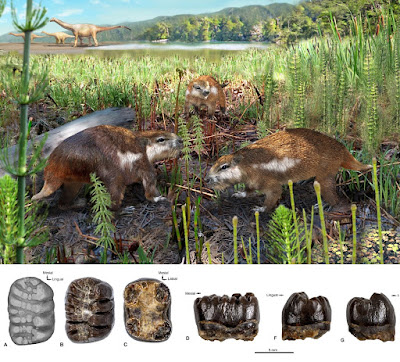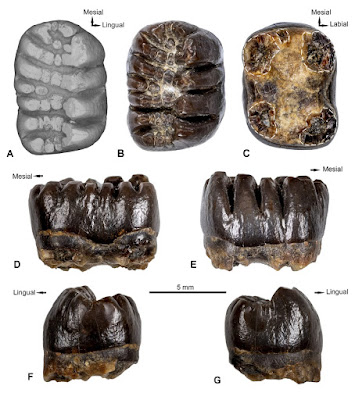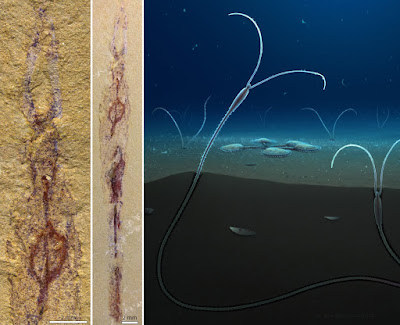[Most Recent Entries] [Calendar View]
Friday, June 12th, 2020
| Time | Event | ||||||||
| 4:15a | [PaleoMammalogy • 2020] Magallanodon baikashkenke • First Mesozoic Mammal from Chile: the Southernmost Record of A late Cretaceous Gondwanatherian
Abstract We describe Magallanodon baikashkenke gen. et. sp. nov., a new gondwanatherian mammal from the Late Cretaceous of the Magallanes Region in southern Chile (Río de Las Chinas Valley, Estancia Cerro Guido, north of Puerto Natales city, Última Esperanza Province). The mammal-bearing layer is placed within the Late Campanian-Early Maastrichtian levels of the Dorotea Formation (Magallanes/ Austral Basin). The new remains constitute the southernmost record of a Mesozoic gondwanatherian mammal, as well as the first Mesozoic mammal from Chile. This taxon is comparable in size to the hypsodont-toothed Gondwanatherium (Late Cretaceous) and Sudamerica (Early Paleocene) but with noticeably brachyodont molariforms supported by four to five roots. As in other gondwanatherians, it has at least one hypertrophied, rodent-like incisor in the upper jaw. The new taxon is here diagnosed and described, and is regarded as a possible ferugliotheriid (?Ferugliotheriidae). If confirmed, it would represent the largest known taxon for this family. Its molariform occlusal crown pattern, after wear, resembles that of other gondwanatherians, particularly ferugliotheriids and that of the sudamericid Gondwanatherium. This adds new evidence on the phylogenetic proximity of ferugliotheriid and sudamericid gondwanatherians. An analysis of the enamel microstructure of the upper incisor of Magallanodon was performed demonstrating several crucial similarities with the pattern shown by Gondwanatherium (Sudamericidae). We discuss the significance of Magallanodon for understanding the acquisition, within gondwanatherians, of a lophed molariform pattern. Finally, we discuss the significance of the new finding in the context of southern biotas, including those of Patagonia and Antarctica. Keywords: Gondwanatheria, Mammalia, Molariforms, Campanian-Maastrichtian, Dorotea Formation, Magallanes/Austral Basin, Chile. SYSTEMATIC PALEONTOLOGY MAMMALIA Linnaeus 1758 GONDWANATHERIA Mones 1987 ?FERUGLIOTHERIIDAE Bonaparte 1986 Genus Magallanodon nov. Type Species: Magallanodon baikashkenke sp. nov. Magallanodon baikashkenke sp. nov. Derivation of name: The generic name comes from the Magallanes Region in Southern Chile, and odontos, Greek for “tooth”. The specific name derives from the Tehuelchian terms bai (grandfather) and kashkenke (valley). Grandfather’s Valley is the aboriginal name for the current valley of the Río de Las Chinas, where the type locality is placed. Holotype specimen: CPAP5916, first lower left molariform (mf1; Figs. 3, 4). Hypodigm: The type and specimens CPAP 5906, an upper right mesial incisor (Figure 5), and the molariforms CPAP 3223 and CPAP 3224, a left and a right ?MF4, respectively (Figure 6). Diagnosis: Large-sized gondwanatherian (mesio-distal length of mf1=8.34 mm; see Table 1) which can be distinguished from other gondwanatherians by the following combination of features: brachyodont molariforms with four to five roots; molariforms with distinct transverse lophs which in unworn condition are formed by multiple rounded adjacent cuspules; mesial lower molariform crown with four main lobes, the mesial one D-shaped, the second formed by a longitudinal ridge, and the third and fourth V/U-shaped in occlusal view, all of them separated by continuous labio-lingual grooves that open on the lingual wall of the crown as deep furrows; the lobes define seven cuspules on the labial margin of the crown of mf1; distalmost upper molariforms with two lobes divided by a transverse groove that starts in the labial edge and does not reach the lingual side; presence of islets on the worn occlusal surface of the lobes; distalmost upper molariforms with crown distal width ¾ smaller than the mesial width. CONCLUSION: We describe the first Mesozoic mammal for Chile, discovered in the Upper Cretaceous Dorotea Formation (Magallanes/Austral Basin) at the Río de Las Chinas Valley, Estancia Cerro Guido, Última Esperanza Province, Magallanes Region, southern Chile. It is based on isolated teeth (one incisor and three molariforms) that represent a new genus and species, Magallanodon baikashkenke, included into the allotherian clade Gondwanatheria. Based on its gross occlusal morphology and brachyodont molariforms it is tentatively referred to ?Ferugliotheriidae, which at the moment was endemic for northern Patagonia, Argentina. The relatively large size of this species coupled with its large, hypsodont incisors and brachyodont molariforms highlight the ecological disparity of this group during the Late Cretaceous. This new gondwanatherian record also represents the southernmost for the Cretaceous, but the occurrence of members of this clade in the Antarctic Peninsula during the middle to late Eocene, supports a long-lasting presence in southern latitudes since at least the near end of the Mesozoic. Francisco J. Goin, Agustín G. Martinelli, Sergio Soto-Acuña, Emma C. Vieytes, Leslie M.E. Manríquez, Roy A. Fernández, Juan Pablo Pino, Cristine Trevisan, Jonatan Kaluza, Marcelo A. Reguero, Marcelo Leppe, Héctor Ortiz, David Rubilar-Rogers and Alexander O. Vargas. 2020. First Mesozoic Mammal from Chile: the Southernmost Record of A late Cretaceous Gondwanatherian. Boletín del Museo Nacional de Historia Natural, Chile. 69(1); 5-31. publicaciones.mnhn.gob.cl/668/w3-article-9 Resumen: Primer mamífero Mesozoico de Chile: el registro más austral de un gondwanaterio del Cretácico tardío. Se describe a Magallanodon baikashkenke gen. et. sp. nov., un nuevo mamífero gondwanaterio del Cretácico tardío de la Región de Magallanes, en el sur de Chile (Valle del Río de Las Chinas, Estancia Cerro Guido, norte de Puerto Natales, Provincia de Última Esperanza). Las capas portadoras se ubican entre los niveles del Campaniano tardío-Maastrichtiano temprano de la Formación Dorotea (Cuenca de Magallanes/Austral). Los nuevos restos constituyen el registro más austral de un mamífero gondwanaterio del Mesozoico, como así también el primer mamífero Mesozoico conocido para Chile. El nuevo taxón es comparable en tamaño a las formas hipsodontes Gondwanatherium (Cretácico tardío) y Sudamerica (Paleoceno temprano), pero con molares notoriamente braquidontes soportados por cuatro a cinco raíces. Como en otros gondwanaterios, posee al menos un incisivo superior rodentiforme en la serie superior. Se diagnostica y describe brevemente el nuevo taxón, considerado tentativamente como un ferugliotérido (Ferugliotheriidae). De confirmarse esta asignación, este nuevo taxón representaría el miembro de mayor tamaño para la familia. El patrón oclusal de los molariformes, con el desgaste, se semeja también al de otros gondwanaterios, en particular al de los ferugliotéridos y al del sudamerícido Gondwanatherium, agregando en consecuencia más evidencias en favor de la proximidad filogenética entre ambas familias. Se llevó a cabo un análisis de la microestructura del esmalte del incisivo superior de Magallanodon; como resultado, se encontraron varias similitudes importantes con el patrón existente en Gondwanatherium (Sudamericidae). Se discute la significación de Magallanodon en la adquisición, entre los gondwanaterios, de un patrón molariforme caracterizado por la presencia de lofos transversos. Finalmente, se discute la significación del nuevo hallazgo en el contexto de las biotas australes, incluyendo aquellas de Patagonia y Antártica. Palabras claves: Gondwanatheria, Mammalia, Molariformes, Campaniano-Maastrichtiano, Formación Dorotea, Cuenca de Magallanes/Austral, Chile. | ||||||||
| 8:32a | [Paleontology • 2020] Dannychaeta tucolus • A Cambrian Crown Annelid Reconciles Phylogenomics and the Fossil Record
Abstract The phylum of annelids is one of the most disparate animal phyla and encompasses ambush predators, suspension feeders and terrestrial earthworms. The early evolution of annelids remains obscure or controversial, partly owing to discordance between molecular phylogenies and fossils. Annelid fossils from the Cambrian period have morphologies that indicate epibenthic lifestyles, whereas phylogenomics recovers sessile, infaunal and tubicolous taxa as an early diverging grade. Magelonidae and Oweniidae (Palaeoannelida1) are the sister group of all other annelids but contrast with Cambrian taxa in both lifestyle and gross morphology. Here we describe a new fossil polychaete (bristle worm) from the early Cambrian Canglangpu formation that we name Dannychaeta tucolus, which is preserved within delicate, dwelling tubes that were originally organic. The head has a well-defined spade-shaped prostomium with elongated ventrolateral palps. The body has a wide, stout thorax and elongated abdomen with biramous parapodia with parapodial lamellae. This character combination is shared with extant Magelonidae, and phylogenetic analyses recover Dannychaeta within Palaeoannelida. To our knowledge, Dannychaeta is the oldest polychaete that unambiguously belongs to crown annelids, providing a constraint on the tempo of annelid evolution and revealing unrecognized ecological and morphological diversity in ancient annelids.
Annelida Lamarck, 1809 Palaeoannelida Weigert & Bleidorn, 2016 Magelonidae Cunningham & Ramage, 1888 Dannychaeta tucolus gen. et sp. nov. Etymology. Danny refers to Danny Eibye-Jacobsen, for his contributions to our understanding of early annelids; chaeta (Latin), bristle; tubus (Latin), tube; colus (Latin), dwelling in. Holotype. YKLP 11382 part and counterpart (YKLP, Yunnan Key Laboratory for Palaeobiology) Horizon and locality. Canglangpu Formation, Cambrian stage, Hongjingshao Member (around 514 million years ago), at southwest of Guanshan reservoir, Chenggong, Kunming, China. Diagnosis. Elongated, slender polychaetes with organic dwelling tubes. Head with anteriorly tapering spade-shaped prostomium, with paired palps attached ventrolaterally near the mouth. Body heteronomously segmented, with a wider thorax containing at least eight chaetigers. Parapodia with lateral lamellae in the posterior part of the abdomen. Abdominal parapodia biramous, unknown in thorax. Capillary chaetae in both rami, occurring in tight parallel bundles.
Hong Chen, Luke A. Parry, Jakob Vinther, Dayou Zhai, Xianguang Hou and Xiaoya Ma. 2020. A Cambrian Crown Annelid Reconciles Phylogenomics and the Fossil Record. Nature. DOI: 10.1038/s41586-020-2384-8 |
| << Previous Day |
2020/06/12 [Calendar] |
Next Day >> |










